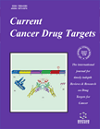- Home
- A-Z Publications
- Current Cancer Drug Targets
- Previous Issues
- Volume 25, Issue 2, 2025
Current Cancer Drug Targets - Volume 25, Issue 2, 2025
Volume 25, Issue 2, 2025
-
-
A Review on Patient-derived 3D Micro Cancer Approach for Drug Screen in Personalized Cancer Medicine
More LessAuthors: Zülal Atlı Şekeroğlu and Vedat ŞekeroğluPrecision medicine in oncology aims to identify an individualized treatment plan based on genomic alterations in a patient’s tumor. It helps to select the most beneficial therapy for an individual patient. As it is now known that no patient's cancer is the same, and therefore, different patients may respond differently to conventional treatments, precision medicine, which replaces the one-size-fits-all approach, supports the developm Read More
-
-
-
CNDP1 Suppresses the Malignant Behavior of Hepatoma Cell via Restricting PI3K-AKT-mTOR Activation
More LessAuthors: Youwen Du, Linxin Pan, Wenchen Zhang, Shuangbiao Wei, Xu Fan, Na Zhang, Pengjun Wei, Xiaoqian Chen, Zhi Qiao and Li XieIntroductionHepatocellular carcinoma (HCC) is a global health problem with increasing morbidity and mortality, and exploring the diagnosis and treatment of HCC at the gene level has become a research hotspot in recent years. As the rate-limiting enzyme of carnosine hydrolysis, CNDP1 participates in the progress of many diseases, but its function in HCC has not been fully elucidated.MethodsThis study firstly screened dif Read More
-
-
-
HAND2-AS1 Promotes Ferroptosis to Reverse Lenvatinib Resistance in Hepatocellular Carcinoma by TLR4/NOX2/DUOX2 Axis
More LessAuthors: Zheng Song, Yu Zhang, Wei Luo, Chao Sun, Caihong Lv, Sihao Wang, Quanwei He, Ran Xu, Zhaofang Bai, Xiujuan Chang and Yongping YangIntroductionLenvatinib resistance causes less than 40% of the objective response rate. Therefore, it is urgent to explore new therapeutic targets to reverse the lenvatinib resistance for HCC. HAND2-AS1 is a critical tumor suppressor gene in various cancers.MethodsHere, we investigated the role of HAND2-AS1 in the molecular mechanism of lenvatinib resistance in HCC. It was found that HAND2-AS1 was lowly expressed in the He Read More
-
-
-
PLCG2, A Regulator of Lung Adenocarcinoma Proliferation and Migration Associated with Immune Infiltration
More LessAuthors: Shuhui Chen, Chenkang Zhou, Jieying Dai, Qingqing Xu, Yuxin Chen, Zhaoting Hu, Yumin Wang and Caihong WangBackgroundResults from the TCGA database showed that phosphatidylinositol-specific phospholipase Cγ2 (PLCG2) expression level in Lung Adenocarcinoma (LUAD) was notably decreased compared to adjacent tissues, so we unveiled its role of LUAD.ObjectiveThis study aims to explore the expression and clinical significance of Phosphatidylinositol-specific phospholipase Cγ2 (PLCG2) in lung adenocarcinoma (LUAD) cells Read More
-
-
-
Gamma-tocotrienol Inhibits Proliferation and Growth of HSD17B4 Overexpressing HepG2 Liver Cancer Cells
More LessAuthors: Xiaoming Wang, Xijia Liang, Nan Zhang, Yaqi Wang, Meng Hu, Yun Shi, Min Yao, Lianguo Hou and Lingling JiangIntroductionHydroxysteroid 17-beta dehydrogenase 4 (HSD17B4) is involved in the progression of hepatocellular carcinoma (HCC).AimsThis study aimed to investigate the inhibitory effect of gamma-tocotrienol (γ-T3) on the proliferation and growth of HSD17B4-overexpressing HepG2 cells.MethodsHepG2 cells were transfected with empty or HSD17B4-overexpressing plasmids, followed by vitamin E (VE) or γ-T3 treatme Read More
-
-
-
Screening miRNAs to Hinder the Tumorigenesis of Renal Clear Cell Carcinoma Associated with KDR Expression
More LessIntroductionThis study delved to understand the role of Kinase Insert Domain Receptor (KDR) and its associated miRNAs in renal cell carcinoma through an extensive computational analysis. The potential of our findings to guide future research in this area is significant.MethodsOur methods, which included the use of UALCAN and GEPIA2 databases, as well as miRDB, MirDIP, miRNet v2.0, miRTargetLink, MiEAA v2.1, TarBase v8 Read More
-
-
-
Transforming Cancer Care: The Impact of AI-driven Strategies
More LessAuthors: Debanjan Mukherjee, Debajyoti Roy and Shubham ThakurAI is a critical component in healthcare, especially in the application of precision medicine where patients’ characteristics, including genetic makeup, determine the treatment options that should be implemented. AI sorts big data, predicting people’s reactions to specific treatments, the right combinations of drugs, and possible side effects, therefore increasing the efficiency of the treatment process and decreasing nega Read More
-
Volumes & issues
-
Volume 25 (2025)
-
Volume 24 (2024)
-
Volume 23 (2023)
-
Volume 22 (2022)
-
Volume 21 (2021)
-
Volume 20 (2020)
-
Volume 19 (2019)
-
Volume 18 (2018)
-
Volume 17 (2017)
-
Volume 16 (2016)
-
Volume 15 (2015)
-
Volume 14 (2014)
-
Volume 13 (2013)
-
Volume 12 (2012)
-
Volume 11 (2011)
-
Volume 10 (2010)
-
Volume 9 (2009)
-
Volume 8 (2008)
-
Volume 7 (2007)
-
Volume 6 (2006)
-
Volume 5 (2005)
-
Volume 4 (2004)
-
Volume 3 (2003)
-
Volume 2 (2002)
-
Volume 1 (2001)
Most Read This Month
Article
content/journals/ccdt
Journal
10
5
false
en


